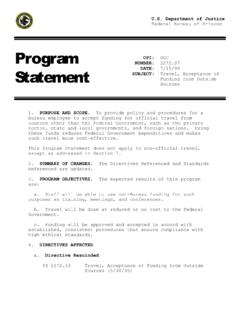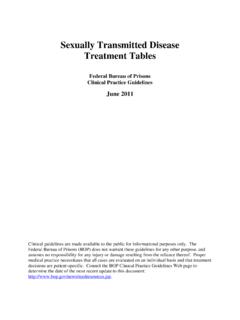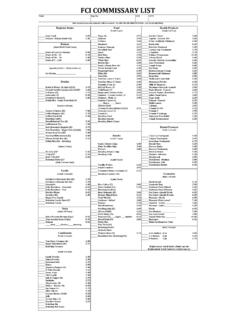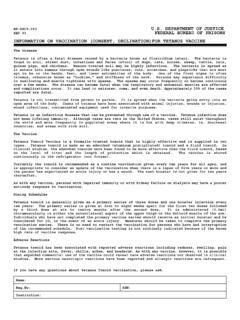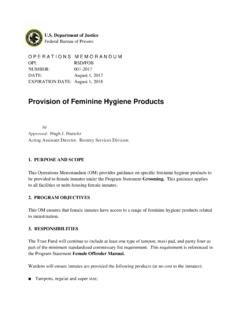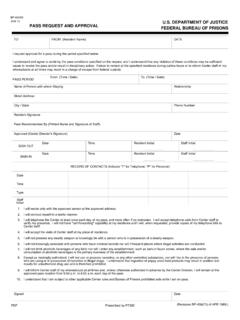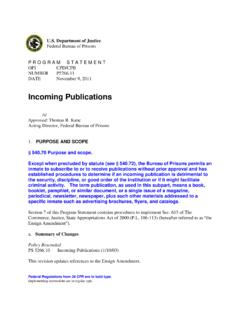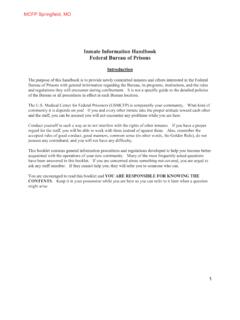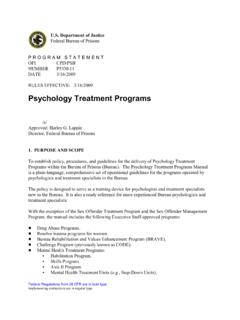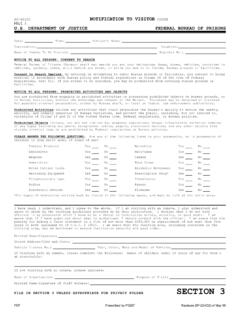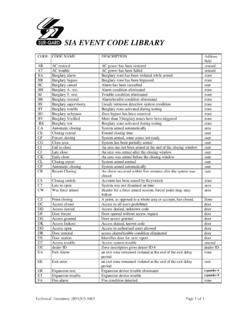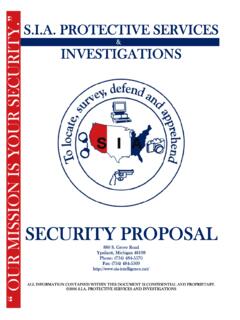Transcription of Federal Bureau of Prisons
1 Federal Bureau of Prisons Privacy Impact Assessment for the Forensic Laboratory Issued by: Sonya D. Thompson, Senior Component Official for Privacy, Sr. Deputy Assistant Director/CIO Approved by: Erika Brown Lee, Chief Privacy and Civil Liberties Officer, Department of Justice Date approved: [November 18, 2014] Department of Justice Privacy Impact Assessment [BOP/Forensic Lab] 2 Section 1: Description of the Information System The Federal Bureau of Prisons (BOP) protects society by confining offenders in the controlled environments of Prisons , and community-based facilities that are safe, humane, and appropriately secure, and which provide work and other self-improvement opportunities to assist offenders in becoming law-abiding citizens.
2 In accordance with sound correctional security practices, the BOP uses various security methods to detect and deter the use of unauthorized cell phones in its Prisons . When such contraband is confiscated, retrieved cell phones are sent to the BOP s Forensic Laboratory (Lab) in Washington, for analysis. The Lab was established to assist BOP staff in recovering information from unauthorized cellular phones in order to determine if criminal or illegal activity has or is occurring. The original lab was first developed and implemented in 2009 pursuant to 18 1791, which was later updated in 2010 when Congress passed the Contraband Cell Phone Act of 2010, 111-225, 18 1791. This Act prohibits the possession of cell phones in Prisons by unauthorized persons, including visitors providing a cell phone to an inmate, or for an inmate to possess a cell phone.
3 When a cellular device is retrieved at an institution, the cellular device is sent to the Lab whereby lab technicians use various forensic software tools to extract information, including incoming and outgoing phone numbers dialed from and to the phone, and text messages and images stored on the phone s memory (internal and SD card). In addition, artifacts are produced from such analysis, such as metadata ( , subscriber information, device type, serial numbers, cell towers, location base via GPS and all other data that can identify the device specifically to providers), email contents, and local applications use and content, including web browsing history, remote/cloud activity, SMS, Skype, WIFI connections and Social networking Services (SNS).
4 The Lab also performs forensic analysis of other types of mobile devices ( , tablets), as well as computer forensics of laptops and workstations, when required. Extracted data from the device is compiled into a report at the Lab and sent back electronically to the forwarding institution for further investigation by local intelligence staff. BOP intelligence staff use this extracted information to determine if illicit or criminal activity is occurring and who was potentially responsible for smuggling the cell phone into the institution. Further, such information may be shared with other components within the Department of Justice, in addition to Federal , state and local law enforcement agencies, for purposes of criminal investigation.
5 The Lab's IT system is a stand-alone infrastructure consisting of workstations (hardware), software and local Network-attached storage, in order to share data among forensic workstations and BOP Lab staff. The only individuals with physical access to the Lab and to the equipment and software therein are staff assigned to the Central Office Intelligence Section, which includes BOP staff forensic analysts. The Lab is physically secured inside BOP s headquarters using a Personal Identity Verification (PIV) card which is controlled and enabled via use of a Physical Access Control System. Workstations are secured by requiring individuals to log in with user identification (userID) and password authentication. Data stored on any external hard drives is encrypted.
6 The Lab s workstations are not interconnected to any other BOP system. Department of Justice Privacy Impact Assessment [BOP/Forensic Lab] 5 network with physical and electronic access only assigned to forensic examiners in the Lab. Access is role-based and in accordance with security clearances as noted in Section The network is protected by a firewall and Active Directory Domain. Access to the network, and data stored therein, requires a userID and password. Additional system security is provided at the data storage level through the use of disk encryption. Further, as described in Section I, physical access to the Lab requires authorization through a PIV-card, controlled and enabled via use of a Physical Access Control System.
7 These measures mitigate unauthorized physical access to the Lab and its IT infrastructure. Highly-sensitive data extracted from the phones, contained in hard-copy documents and reports, is stored in a locked safe within the Lab. Combinations are known only by the examiners assigned to the Lab. In case of an emergency, the Correctional Service Administrator (CSA) can override the combination with a key that is stored offsite in a safe protected by another PIV-controlled access system. The CSA does not have direct access to the Lab with his or her PIV-card. All visitors and non-Lab BOP staff must sign in and be escorted at all times. Also, there is a privacy risk related to the inadvertent disclosure of sensitive information to persons not authorized to receive it.
8 To mitigate this risk, sensitive data retrieved from confiscated phones is only shared with intelligence staff and Chief Executive Officers (CEOs) at the site where the phone was retrieved for further investigation. All BOP staff members, including lab technicians, are annually trained on how to properly handle sensitive information. Access to any relevant data is limited to those persons who have an appropriate security clearance which is regularly reviewed. In general, information is safeguarded in accordance with BOP rules and policies governing security of and access to information systems. These safeguards include the maintenance of records and technical equipment in restricted areas, and the required use of proper passwords and user identification to access the system.
9 Section 3: Purpose and Use of the System Indicate why the information in the system is being collected, maintained, or disseminated. (Check all that apply.) Purpose X For criminal law enforcement activities For civil enforcement activities X For intelligence activities For administrative matters X To conduct analysis concerning subjects of investigative or other interest To promote information sharing initiatives X To conduct analysis to identify previously unknown areas of note, concern, or pattern ( , a possible source for introduction of contraband; an identified security breach or vulnerability within a particular institution). For administering human resources programs For litigation Other (specify): Department of Justice Privacy Impact Assessment [BOP/Forensic Lab] 6 Analysis: Provide an explanation of how the component specifically will use the information to accomplish the checked purpose(s).
10 Describe why the information that is collected, maintained, or disseminated is necessary to accomplish the checked purpose(s) and to further the component s and/or the Department s mission. The BOP uses the information collected from confiscated phones to determine if criminal or illegal activity has or is occurring. The BOP also uses the information extracted from the device to identify the responsible party who smuggled the cell phone into the institution, and who has used the device since its introduction into the institution. The information is used for internal intelligence activities associated with the safe and orderly operation and security of BOP institutions. The BOP also may share data on a case-by-case basis with external Federal law enforcement task forces for criminal investigations and intelligence gathering.
